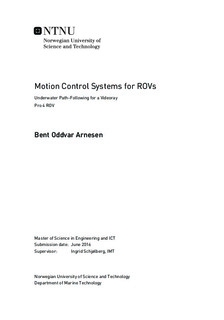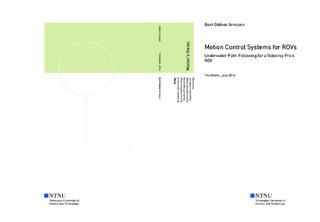| dc.description.abstract | Remotely operated vehicles (ROVs) are used for an increasing amount of underwater applications, ranging from being hobby-related to having military and scientific interests. ROVs may incorporate automatic control strategies, making them capable of carrying out complex missions single-handedly, in a safe and efficient manner. This master's thesis describes the development and implementation of several systems and functionalities for a Videoray Pro 4 ROV. In the thesis, "Videoray Pro 4 ROV", "Videoray ROV", "the ROV" and the like may all be used interchangeable, and it should be clear from the text what it refers to.
The most significant scientific contribution made by this master's thesis is the presentation of experimental testing of successful underwater path-following for a Videoray Pro 4 ROV. The methodology is based on a set of predefined waypoints in 3-D space, and generates paths between each consecutive waypoint location. The ROV uses a technique called lookahead-based line-of-sight steering to follow the path segments and traverse the waypoints. When the distance to the current waypoint is within some \textit{radius of acceptance}, a switching controller will command the ROV to follow the path leading to the next waypoint location.
The force produced by the propellers can easily be controlled with a \textit{Dualshock 3} hand-held controller, i.e., the \textit{user interaction unit}. Occasionally, there are problems with the hand-held controller freezing for about three seconds, due to a problem with the software managing this system. The issue seems to occur when the buffer storing the joystick input commands is filled up faster than it is being read. If the buffer is full, it will initialize a process that forces it to empty completely. The controller will then stop taking input, and will freeze at the final command received. This means that the thrusters will freeze at the last command received for about three seconds as well. When the thrusters freeze, if the previous command given was "0", the ROV will simply stand still. However, if the command was, say, "give 30\% force in surge", the thrusters will give 30\% thrust for about three seconds. This may have hazardous consequences to the ROV and nearby equipment. Attempts have been made to change the buffer size, but without luck.
It is difficult to make the ROV move with a very low velocity, due to physical limitations in the thruster system. In the later stages of the experimental work, the cause of the restrictions on the thrusters was identified. One of the cartridge seals has less oil than what is needed to properly lubricate the propeller shaft, meaning that the thrusters cannot produce forces below certain limits. The physical explanation to this is that the propeller is unable to overcome the static friction force in the shaft. Much oil is still left in the port-thruster cartridge seal, but this is not the case for the starboard thruster. An air-bubble indicates how much oil is left, and when the air bubble is 3/4 full, the cartridge seal should be replaced. Not only does this capsule ensure proper lubrication of the propeller shaft, but it also keeps water out of the pressure hull and prevents oxidation. The starboard cartridge seal has an air bubble that stretches throughout the whole capsule, meaning that it should have been replaced a while ago. The Videoray ROV therefore experience difficulties when controlling the heading, and is bound to have a velocity greater than desired in order to move forward. This forces the ROV to move slightly beyond the desired location. The magnitude of this overshoot depends on the radius of acceptance and the ROV's velocity at the waypoint. Using a radius of acceptance equal to 10 cm, the ROV will move past the waypoint with about 5-10 cm. Replacing the existing cartridge seal with a new one will allow the ROV to move at lower speeds, implying better path-following performance.
The Qualisys Motion Tracking system has been used to receive position and orientation data for the ROV. This system captures a set of markers using \textit{optical tracking technology}. Markers are attached to a rig, which is fastened to ROV's bottom side. A lot of time and experimental work was dedicated to make rig, markers and Qualisys work together to receive measurements consistently. Difficulties were experienced with receiving position data for an area large enough to perform path-following. Eventually, it was concluded that improvements had to be made for the rig. Extending arms were created and attached to the rig. In addition to adjusting the camera settings and turning off ceiling light to reduce light reflection, acceptable response from the Qualisys camera system was achieved. Position and orientation data could now be extracted at a reliable rate, but random data drop-outs for tenths of a second still occurred. The data loss that lasts for shorter durations than a second are handled by a simple algorithm, which uses the previously measured position data directly.
In the beginning of the thesis work, a lateral thruster was mounted on the ROV, and code was developed to make this thruster work. Unfortunately, it communicated in a different manner than the other thrusters, with a method called \textit{round-robin} or 1/2 duplex. Lacking documentation and difficulties communicating with the manufacturers of this thruster prolonged simultaneous control of all thrusters. Contact was made with Andrew Goldstein, Director of Software Engineering, Videoray LCC, in the beginning of January. In the later stages of the thesis work, Andrew found the time to help out with the documentation, and all the thrusters can now be controlled in a satisfactory manner. Therefore, future work with the Videoray ROV can benefit from a fully actuated underwater vehicle. Along with the successful implementation of waypoint guidance and path-following, the ROV may in the future be used to carry out a great variety of underwater control objectives. | |

